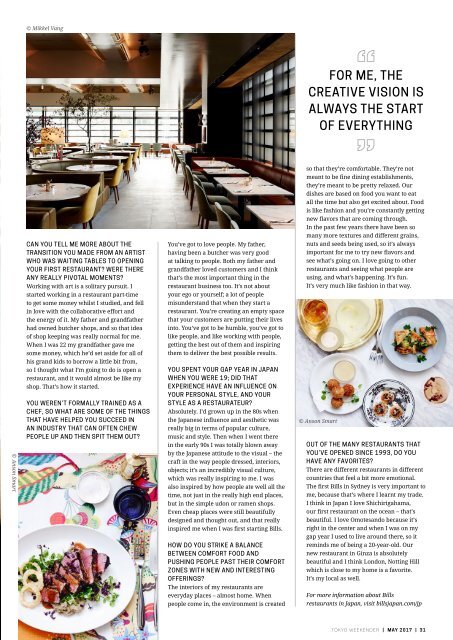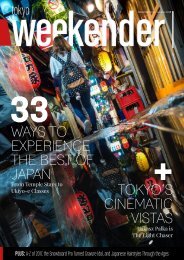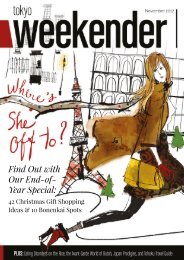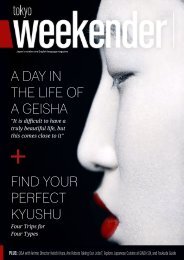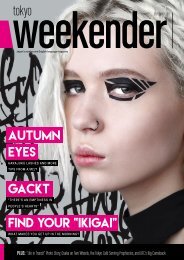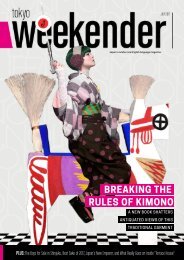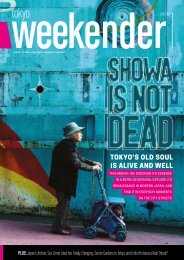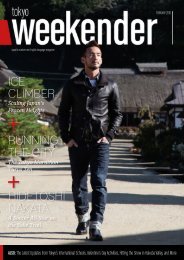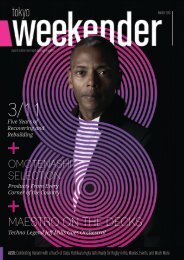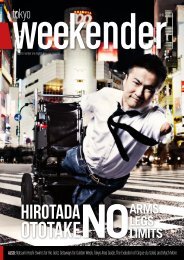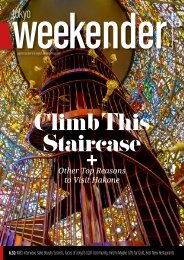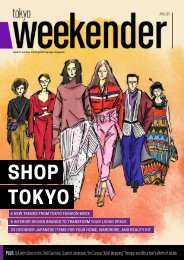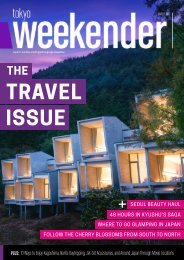Tokyo Weekender - May 2017
Meet the hyperreal body artist, the illusionist, the contortionist, and the acrobat who are all helping to put the country on the global talent map. Plus we go inside Nara’s abandoned theme park, Q&A with chef Bill Granger, Japan’s child poverty crisis, and our Spring education special
Meet the hyperreal body artist, the illusionist, the contortionist, and the acrobat who are all helping to put the country on the global talent map. Plus we go inside Nara’s abandoned theme park, Q&A with chef Bill Granger, Japan’s child poverty crisis, and our Spring education special
You also want an ePaper? Increase the reach of your titles
YUMPU automatically turns print PDFs into web optimized ePapers that Google loves.
© Mikkel Vang<br />
FOR ME, THE<br />
CREATIVE VISION IS<br />
ALWAYS THE START<br />
OF EVERYTHING<br />
so that they’re comfortable. They’re not<br />
meant to be fine dining establishments,<br />
they’re meant to be pretty relaxed. Our<br />
dishes are based on food you want to eat<br />
all the time but also get excited about. Food<br />
is like fashion and you’re constantly getting<br />
new flavors that are coming through.<br />
In the past few years there have been so<br />
many more textures and different grains,<br />
CAN YOU TELL ME MORE ABOUT THE<br />
TRANSITION YOU MADE FROM AN ARTIST<br />
WHO WAS WAITING TABLES TO OPENING<br />
YOUR FIRST RESTAURANT? WERE THERE<br />
ANY REALLY PIVOTAL MOMENTS?<br />
Working with art is a solitary pursuit. I<br />
You’ve got to love people. My father,<br />
having been a butcher was very good<br />
at talking to people. Both my father and<br />
grandfather loved customers and I think<br />
that’s the most important thing in the<br />
restaurant business too. It’s not about<br />
nuts and seeds being used, so it’s always<br />
important for me to try new flavors and<br />
see what’s going on. I love going to other<br />
restaurants and seeing what people are<br />
using, and what’s happening. It’s fun.<br />
It’s very much like fashion in that way.<br />
started working in a restaurant part-time<br />
your ego or yourself; a lot of people<br />
to get some money whilst I studied, and fell<br />
misunderstand that when they start a<br />
in love with the collaborative effort and<br />
restaurant. You’re creating an empty space<br />
the energy of it. My father and grandfather<br />
that your customers are putting their lives<br />
had owned butcher shops, and so that idea<br />
into. You’ve got to be humble, you’ve got to<br />
of shop keeping was really normal for me.<br />
like people, and like working with people,<br />
When I was 22 my grandfather gave me<br />
getting the best out of them and inspiring<br />
some money, which he’d set aside for all of<br />
them to deliver the best possible results.<br />
his grand kids to borrow a little bit from,<br />
© Anson Smart<br />
so I thought what I’m going to do is open a<br />
restaurant, and it would almost be like my<br />
shop. That’s how it started.<br />
YOU WEREN’T FORMALLY TRAINED AS A<br />
CHEF, SO WHAT ARE SOME OF THE THINGS<br />
THAT HAVE HELPED YOU SUCCEED IN<br />
AN INDUSTRY THAT CAN OFTEN CHEW<br />
PEOPLE UP AND THEN SPIT THEM OUT?<br />
YOU SPENT YOUR GAP YEAR IN JAPAN<br />
WHEN YOU WERE 19; DID THAT<br />
EXPERIENCE HAVE AN INFLUENCE ON<br />
YOUR PERSONAL STYLE, AND YOUR<br />
STYLE AS A RESTAURATEUR?<br />
Absolutely. I’d grown up in the 80s when<br />
the Japanese influence and aesthetic was<br />
really big in terms of popular culture,<br />
music and style. Then when I went there<br />
in the early 90s I was totally blown away<br />
by the Japanese attitude to the visual – the<br />
craft in the way people dressed, interiors,<br />
objects; it’s an incredibly visual culture,<br />
which was really inspiring to me. I was<br />
also inspired by how people ate well all the<br />
time, not just in the really high end places,<br />
but in the simple udon or ramen shops.<br />
Even cheap places were still beautifully<br />
designed and thought out, and that really<br />
inspired me when I was first starting Bills.<br />
© Anson Smart<br />
OUT OF THE MANY RESTAURANTS THAT<br />
YOU’VE OPENED SINCE 1993, DO YOU<br />
HAVE ANY FAVORITES?<br />
There are different restaurants in different<br />
countries that feel a bit more emotional.<br />
The first Bills in Sydney is very important to<br />
me, because that’s where I learnt my trade.<br />
I think in Japan I love Shichirigahama,<br />
our first restaurant on the ocean – that’s<br />
beautiful. I love Omotesando because it’s<br />
right in the center and when I was on my<br />
gap year I used to live around there, so it<br />
HOW DO YOU STRIKE A BALANCE<br />
BETWEEN COMFORT FOOD AND<br />
PUSHING PEOPLE PAST THEIR COMFORT<br />
ZONES WITH NEW AND INTERESTING<br />
OFFERINGS?<br />
The interiors of my restaurants are<br />
reminds me of being a 20-year-old. Our<br />
new restaurant in Ginza is absolutely<br />
beautiful and I think London, Notting Hill<br />
which is close to my home is a favorite.<br />
It’s my local as well.<br />
everyday places – almost home. When<br />
For more information about Bills<br />
people come in, the environment is created<br />
restaurants in Japan, visit billsjapan.com/jp<br />
TOKYO WEEKENDER | MAY <strong>2017</strong> | 31


